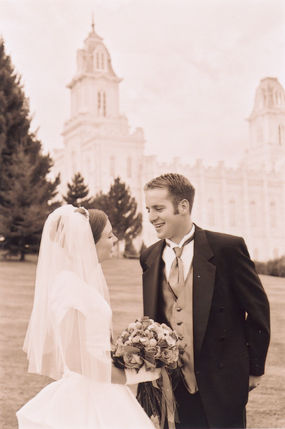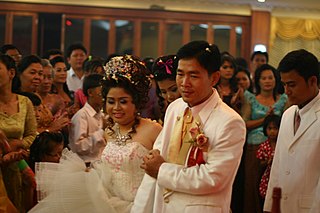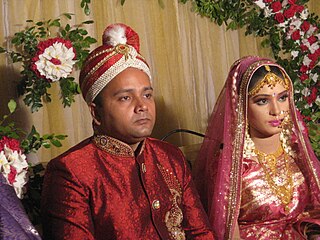Related Research Articles

Marriage, also called matrimony or wedlock, is a culturally and often legally recognized union between people called spouses. It establishes rights and obligations between them, as well as between them and their children, and between them and their in-laws. It is nearly a cultural universal, but the definition of marriage varies between cultures and religions, and over time. Typically, it is an institution in which interpersonal relationships, usually sexual, are acknowledged or sanctioned. In some cultures, marriage is recommended or considered to be compulsory before pursuing any sexual activity. A marriage ceremony is called a wedding.

A wedding is a ceremony where two people are united in marriage. Wedding traditions and customs vary greatly between cultures, ethnic groups, religions, countries, and social classes. Most wedding ceremonies involve an exchange of marriage vows by a couple, presentation of a gift, and a public proclamation of marriage by an authority figure or celebrant. Special wedding garments are often worn, and the ceremony is sometimes followed by a wedding reception. Music, poetry, prayers, or readings from religious texts or literature are also commonly incorporated into the ceremony, as well as superstitious customs.

An engagement or betrothal is the period of time between the declaration of acceptance of a marriage proposal and the marriage itself. During this period, a couple is said to be fiancés, betrothed,intended, affianced, engaged to be married, or simply engaged. Future brides and grooms may be called fiancée (feminine) or fiancé (masculine), the betrothed, a wife-to-be or husband-to-be, respectively. The duration of the courtship varies vastly, and is largely dependent on cultural norms or upon the agreement of the parties involved.

A wife is a woman in a marital relationship. A woman who has separated from her partner continues to be a wife until their marriage is legally dissolved with a divorce judgment. On the death of her partner, a wife is referred to as a widow. The rights and obligations of a wife to her partner and her status in the community and law vary between cultures and have varied over time.
A mail-order bride is a woman who lists herself in catalogs and is selected by a man for marriage. In the twentieth century, the trend was primarily towards women living in developing countries seeking men in more developed nations. The majority of the women making use of these services from the 1970s to the present are from East Asia, Southeast Asia, Eastern Europe, and Latin America. Since the 1990s, large numbers of eastern European women have advertised themselves in such a way, primarily from Russia, Belarus, Ukraine, Georgia and Moldova. Men who list themselves in such publications are referred to as "mail-order husbands", although this is much less common.

Sealing is an ordinance (ritual) performed in Latter Day Saint temples by a person holding the sealing authority. The purpose of this ordinance is to seal familial relationships, making possible the existence of family relationships throughout eternity. Sealings are typically performed as marriages or as sealing of children to parents. They were performed prior to the death of Joseph Smith, and are currently performed in the largest of the faiths that came from the movement, The Church of Jesus Christ of Latter-day Saints. LDS Church teachings place great importance on the specific authority required to perform these sealings. Church doctrine teaches that this authority, called the priesthood, corresponds to that given to Saint Peter in Matthew 16:19.

Celestial marriage is a doctrine that marriage can last forever in heaven. This is a unique teaching of the Church of Jesus Christ of Latter-day Saints or Mormonism, and branches of Mormon fundamentalism.

Traditional Chinese marriage is a ceremonial ritual within Chinese societies that involves not only a union between spouses but also a union between the two families of a man and a woman, sometimes established by pre-arrangement between families. Marriage and family are inextricably linked, which involves the interests of both families. Within Chinese culture, romantic love and monogamy were the norm for most citizens. Around the end of primitive society, traditional Chinese marriage rituals were formed, with deer skin betrothal in the Fuxi era, the appearance of the "meeting hall" during the Xia and Shang dynasties, and then in the Zhou dynasty, a complete set of marriage etiquette gradually formed. The richness of this series of rituals proves the importance the ancients attached to marriage. In addition to the unique nature of the "three letters and six rituals", monogamy, remarriage and divorce in traditional Chinese marriage culture are also distinctive.
A proxy wedding or proxy marriage is a wedding in which one or both of the individuals being united are not physically present, usually being represented instead by other persons (proxies). If both partners are absent, this is known as a double proxy wedding.

Marriage is available in England and Wales to both opposite-sex and same-sex couples and is legally recognised in the forms of both civil and religious marriage. Marriage laws have historically evolved separately from marriage laws in other jurisdictions in the United Kingdom. There is a distinction between religious marriages, conducted by an authorised religious celebrant and civil marriages conducted by a state registrar. The legal minimum age to enter into a marriage in England and Wales is now eighteen since 27 February 2023 whereas previously the minimum age of marriage was 16, with parental permission, this also applies to civil partnership.

Marriage in Korea mirrors many of the practices and expectations of marriages in other societies. Modern practices are a combination of millennia-old traditions and global influences.
The War Brides Act was enacted to allow alien spouses, natural children, and adopted children of members of the United States Armed Forces, "if admissible," to enter the U.S. as non-quota immigrants after World War II. More than 100,000 entered the United States under this Act and its extensions and amendments until it expired in December 1948. The War Brides Act was a part of new approach to immigration law that focused on family reunification over racial exclusion. There were still racial limits that existed particularly against Asian populations, and Chinese spouses were the only Asian nationality that qualified to be brought to the United States under the act. Additionally, the War Brides Act was well supported and easily passed because family members of servicemen were the recipients, but there were concerns over marital fraud which caused some tensions.
The type, functions, and characteristics of marriage vary from culture to culture, and can change over time. In general there are two types: civil marriage and religious marriage, and typically marriages employ a combination of both. Marriages between people of differing religions are called interfaith marriages, while marital conversion, a more controversial concept than interfaith marriage, refers to the religious conversion of one partner to the other's religion for sake of satisfying a religious requirement.
In South Sudan, a ghost marriage is a marriage where a deceased groom is replaced by his brother. The brother serves as a stand in to the bride, and any resulting children are considered children of the deceased spouse. This unusual type of marriage is nearly exclusive to the Dinka (Jieng), Nuer, and Atuot people of South Sudan although instances of such marriages have also occurred in France. These tribes overlap in cultural practices, potentially due to the fact that all of these tribes are cattle-herding pastoralists.
In Chinese tradition, a ghost marriage is a marriage in which one or both parties are deceased. Other forms of ghost marriage are practiced worldwide, notably in France, since 1959. The origins of Chinese ghost marriage are largely unknown but reports of it being practiced today can still be found.

Courtship, marriage, and divorce in Cambodia are important aspects of family life. Customs vary as between rural and urban areas, with many city dwellers being influenced by western ideas. The choice of a spouse is usually undertaken by the families of young men and women, sometimes with the help of a matchmaker. A man usually marries between the ages of nineteen and twenty-five and a woman between sixteen and twenty-two.
In the United States and Canada, weddings follow traditions often based on religion, culture, and social norms. Most wedding traditions in the United States and Canada were assimilated from other, generally European, countries. Marriages in the U.S. and Canada are typically arranged by the participants and ceremonies may either be religious or civil. There is a tradition that the prospective bridegroom ask his future father-in-law for his blessing.

Muslim marriage and Islamic wedding customs are traditions and practices that relate to wedding ceremonies and marriage rituals prevailing within the Muslim world. Although Islamic marriage customs and relations vary depending on country of origin and government regulations, both Muslim men and women from around the world are guided by Islamic laws and practices specified in the Quran. Islamic marital jurisprudence allows Muslim men to be married to multiple women.
Posthumous marriage in France is legal but must be approved by several civil servants and the family of the deceased. France is one of the few countries in which it is legal to marry a partner posthumously.
In Nazi Germany, it was practiced to marry the pregnant fiancée of a fallen soldier to his dead body in order to legalize, otherwise out of wedlock, the child and provide a bride with benefits of being a soldier widow.
References
- ↑ "Multiple female corpses stolen for ghost marriage in Nanyang, Henan; Graveyards install CCTV cameras and adopt cement coffins to prevent thefts 【河南南陽市多具女屍被配冥婚】 【墓地裝監視鏡頭、換水泥棺材防盜】". Hong Kong: Cable TV news. 14 Aug 2019. Retrieved 14 Aug 2019.
- ↑ "Posthumous marriages and the importance of making a will". 25 August 2017.
- ↑ "Qu'est-ce que le mariage posthume, que seul le président de la République peut autoriser ?". Libération (in French). Retrieved 2023-08-21.
- ↑ https://whu.org.pl/2015/06/29/martwy-pan-mlody-teodora-zukowska Dead Bridegroom by Teodora Żukowska
- ↑ Hastings, James, ed. (1908). Encyclopedia of Religion and Ethics. Vol. 4. New York: Charles Scribner's Sons. p. 604 . Retrieved 30 December 2011.
- ↑ Okinawan Culture in the World Yoshio Watanabe 1993, Okinawa Times, Naha p.26-27
- ↑ "Posthumous wedding for man and girl he killed - Telegraph". The Telegraph. London. 2004-08-24. Retrieved 2010-12-07.
- ↑ Isikoff, Michael. "WP 03/30 Theological Uproar in Unification Church; Rev. Theological Uproar in Un". Archived from the original on 2011-01-20. Retrieved 2010-12-07.
- ↑ Lewis, James R. (2005). Controversial New Religions. Oxford University Press. ISBN 9780195156836.
{{cite book}}: CS1 maint: location missing publisher (link) - ↑ "Kim's fiancee to hold traditional wedding". The Gadsden Times . 1982-11-20.
- ↑ "Sex and Marriage: Marriage Rules (Part 2)". Archived from the original on 2002-10-19. Retrieved 2023-06-25.
- ↑ Bartosik, Matt (2009-09-29). "Posthumous Wedding for Beloved and Disabled Bride". NBC Chicago. Archived from the original on 2009-10-03. Retrieved 2023-06-25.
- ↑ McCarthy, Jack (2009-10-05). "Posthumous 'wedding' honors Batavia resident who died of spinal muscular atrophy". The Chicago Tribune. Retrieved 2010-12-07.
- ↑ "Dead Men Don't Get Hitched". United Press International . 1988-04-07. Retrieved 2023-06-25.
- ↑ Woginiak v. Kleiman(Florida Court of Appeals, Third District5 April 1988). Text
- ↑ "Fiancé of Man Killed by Police Takes His Name". New York Times . December 8, 2006.
- 1 2 Postlethwaite, Diana (1996-07-07). "Peggy and Goliath - New York Times". The New York Times. Retrieved 2010-12-07.
- ↑ "Fritz Pfeffer: Encyclopedia II - Fritz Pfeffer - Posthumous Reputation". Archived from the original on 2012-10-26. Retrieved 2010-12-07.